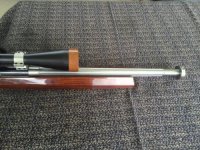At last, the final piece of the puzzle!
Okay guys, after a good night's sleep and plenty of black coffee, I believe I'm ready to tackle this. What I would really like to do is keep my mouth shut, slink away and hide because I've been wrong about something for years.

Yep, completely bassackwards!.

Thanks to Rod Brown, Richard Brensing, Mike Ezell and others, we now know how to tune our rifles by making .001 adjustments during the first match of an agg. Most of us had been making way too big of adjustments and going through in-tune positions, but like Mike said, "Sometimes we got lucky." Getting in tune is one thing; staying in tune throughout the day is quite another. That's where most of us have been confused!

I'll try to explain.
First a question; what makes our rifles go out of tune as the day progresses? Simple! Change in atmospheric conditions due primarily to increases in temperature. As temp goes up, weight of the atmosphere decreases, the bullet encounters less atmospheric resistance as it travels down the bore and begins to exit the muzzle too soon. We can correct for this in one of two ways; (1) reduce the load (2) move the tuner to increase the barrels frequency. But if you're using a tuner, which way do you go; in or out? That's the sixty-four-thousand dollar question and something I've been mistaken about for years!

Yep, old Beggs and most others have always believed that turning the tuner in toward the breech raises the barrel vibration frequency; turning it out toward the muzzle decreases it, BUT THAT'S WRONG! It's exactly the opposite! I'll tell you how I discovered it.


Several months ago, I began wondering exactly what frequency our barrels were vibrating at. Having no sophisticated instrumentation, I thought maybe someone that tunes pianos and other stringed instruments might be able to help. Lo and behold, I found a friendly music store owner who had just what I was looking for!

I grabbed one of my sporter barrels, screwed the tuner discs all the way in to the end of the threads and hot-footed it back to the store! By holding the barrel between the thumb and forefinger at the right spot and striking it with a drummer's stick, the barrel would ring like a bell. Placing the pick up near the barrel showed it was vibrating at 1000 hertz.
I wondered how much the frequency would change if I screwed the tuner 'out' two turns toward the muzzle, expecting it to lower the frequency and was shocked to find this INCREASED the frequency to 1020 hertz! I couldn't believe it! That explained why I had trouble keeping the rifle in tune as temp increased twenty to twenty-five degrees from the first match of the day to the heat of the afternoon. I was going the wrong way!

Well guys, that's about all I've got to say for now. I'm not much of a writer so bear with me. I don't mind owning up to mistakes when I discover I've been wrong about something. That's how we learn.

I hope this post generates more lively discussion.
Later,
Gene Beggs



